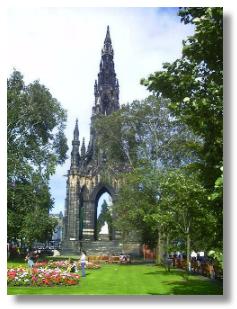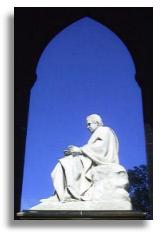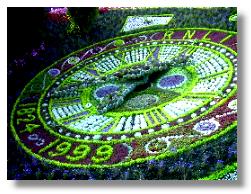 The soaring, Gothic monument to the memory of Sir Walter Scott (who died in 1832) was built in 1840-46 to a design by George Meikle Kemp, a self-taught architect. In the competition to design the monument, Kemp came third but embellished his design to win (though professional architects were not amused). It was influenced by Melrose Abbey and nowadays looks more like a space rocket! The architect had met Scott in 1813 when the author, who was also the Sheriff of Selkirkshire, gave him a lift in his carriage. Kemp entered the competition as "John Morvo" who was a medieval master mason at Melrose Abbey. But he never saw his ideas come to fruition - he tripped in a fog into the Union Canal in 1844 and drowned.
The soaring, Gothic monument to the memory of Sir Walter Scott (who died in 1832) was built in 1840-46 to a design by George Meikle Kemp, a self-taught architect. In the competition to design the monument, Kemp came third but embellished his design to win (though professional architects were not amused). It was influenced by Melrose Abbey and nowadays looks more like a space rocket! The architect had met Scott in 1813 when the author, who was also the Sheriff of Selkirkshire, gave him a lift in his carriage. Kemp entered the competition as "John Morvo" who was a medieval master mason at Melrose Abbey. But he never saw his ideas come to fruition - he tripped in a fog into the Union Canal in 1844 and drowned.
 The sandstone came from a Lothian quarry which, as time has proved, was softer and more liable to corrosion from the atmosphere in "Auld Reekie" as Edinburgh was once called. The stonework has blackened over the years and currently has a "piebald" effect from recent repairs to the stonework.
The sandstone came from a Lothian quarry which, as time has proved, was softer and more liable to corrosion from the atmosphere in "Auld Reekie" as Edinburgh was once called. The stonework has blackened over the years and currently has a "piebald" effect from recent repairs to the stonework.
Placed in Princes Street Gardens, below Edinburgh Castle, the building rises 200.5 feet and has 287 steps to the top. The foundations to support the structure are 52ft deep. The views from there of the Edinburgh skyline (if you can make it up all those stairs) are tremendous. The statue of Scott below the arches of the monument, by Sir John Steel, is made of white Carrara marble. The 30-ton block of marble actually fell into the harbour at Leghorn in Italy on its way to Edinburgh, but that does not seem to have had any adverse effect! The monument is decorated with 64 statuettes, illustrating many of the characters from Scott's novels, placed there in the 1870s, some years after the monument had been completed.
 Not far from the Scott Monument, in Princes Street Gardens, is the "Floral Clock". The clock face is made up of thousands of small plants (many of them are sempervivums) and the hands of the clock are covered in plants too. The clock even tells the right time. In Scotland's climate, the clock is only there in the summer months and has to be replanted every year in the spring.
Not far from the Scott Monument, in Princes Street Gardens, is the "Floral Clock". The clock face is made up of thousands of small plants (many of them are sempervivums) and the hands of the clock are covered in plants too. The clock even tells the right time. In Scotland's climate, the clock is only there in the summer months and has to be replanted every year in the spring.



